- Model NO.: SJ-65/90/120/150 (33: 1)
- Plastic Processed: PVC
- Feeding Mode: One Feed
- Screw: Single-Screw
- Exhaust: Don′t Exhaust
- Computerized: Computerized
- Certification: CE, SGS, ISO9001:2008
- Service: Turn Key Project with Lifelong Service
- Production Experience: Since 1980s in This Plastic Machine Field
- Company Leading Products: WPC Machine, Plastic Profile Machine, Pipe Machine
- Electrical Brand: Siemens, Omron, ABB, etc Famous Brands
- Transport Package: as Export Standard for Plastic Machine Packing
- Origin: Qingdao, China
- Type: Pipe Extruder
- Product Type: PVC Plastic Pipe Extrusion
- Assembly Structure: Separate Type Extruder
- Screw Channel Structure: Deep Screw
- Automation: Automatic
- Plastic Machine Type: Plastic Pipe ( PE, PPR) Water Pipe Extrusion Line
- Application of Plastic Pipe: Telecom Communication, Gas and Water Supply, etc
- Guarantee: 12 Months
- Company Spirit: Customers First, Quality First, Service First
- Extruder: Effective Single Screw Extruder
- Trademark: WEIER
- Specification: SJ-65/33, SJ-90/33, SJ-120/33, SJ-150/33, etc
- HS Code: 94772090
FEATURES OF THIS LINE
Raw material + additive → mixing → vacuum feeding machine → hopper dryer → single screw extruder → color code extruder → mould and calibrator → vacuum forming machine → cooling tank → haul off machine → cutting machine → stacker  Â
1)Â Single screw extruder
adopts long L/D, high efficiency screw, high extrusion capacity, uniformed plasticization. Extruder and haul off machine motors adopt imported AC/DC inverter as speed regulators.Â
2)Â Extrusion die head
is spiral type, good calibrating makes good quality pipe production.
Inner heating system, high efficient, easy extrusion. Bronze calibrators can make the pipes fast calibrated and cooled.
3)Â Vacuum calibrating tank and water spraying cooling tank
adopts advanced water circulation, high pressure cooling system, installed with vacuum degree adjusting device and automatic water temperature and water level controlling system.
4)Â Haul off machineÂ
adopts caterpillar type, which includes two-claw types, three-claw types, four-claw types, six-claw types, eight -claw types, ten-claw types, twelve-claw types etc, suitable for different sizes of pipes.
5)Â Non-scraped cutting, saw cutting or planetary cutting
can be applied, accurate cutting, reliable property, high efficiency. Meter-counting device is also installed.
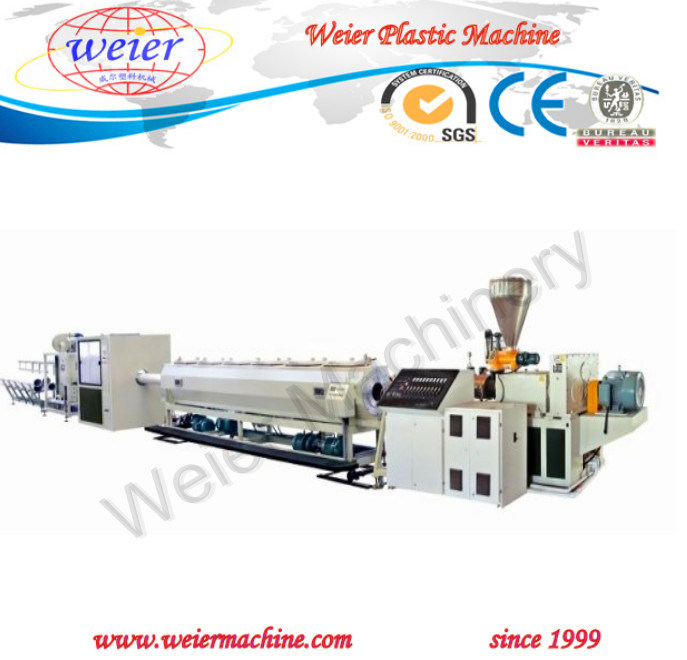
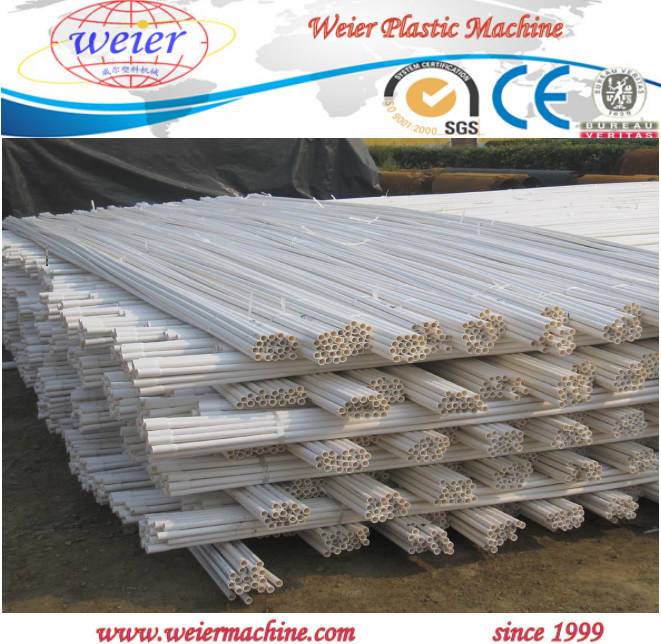
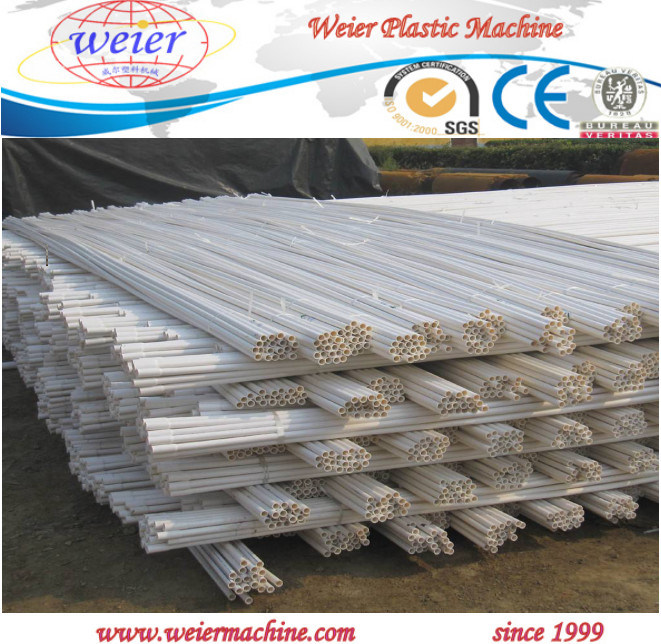
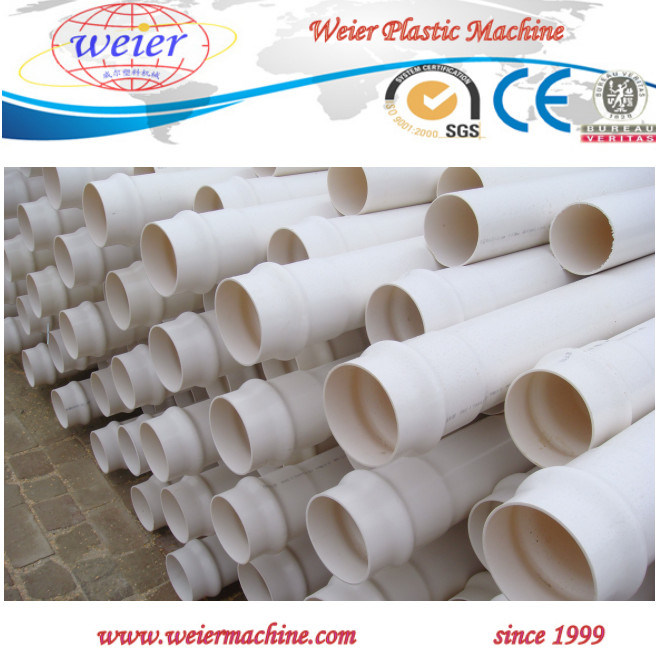
ADVANTAGES OF THE PIPES PRODUCED BY THIS LINE
Pipe produced by this line has excellent hardness and flexibility, heat resistance, aging resistance, high mechanical strength, environmental stress cracking resistance and creep resistance, hot-melt connectivity, and other advantages, it is the first choice of city gas and water transmission pipe line.
WHY CHOOSE WEIER?
| (1) We have experiences in this field since 1980s |
| (2) We have our production bases for WPC and plastic product in China with large scales, which shows our machine's production ability |
| (3) We have strong technical teams and cooperate with China scientific institution to develop, improve and test our machine, to ensure what customers get are the most reliable machines from China. |
| (4) We select the most reliable mechanical and electrical parts for our machine with all famous reliable brands, with European CE certificated. |
| (5) We put our heart into every business with aim for a long term cooperation with clients from all over the world. |
| (6) We have perfect service system-- Our president is devoting himself to pre-sale, on-sale and after-sale service. |
Â
Engine Block – This is the very core of the engine. Often made of aluminum or iron, it has several holes to contain the cylinders as well as provide water and oil flow paths to cool and lubricate the engine. Oil paths are narrower than the water flow paths. The engine block also houses the pistons, crankshaft, camshaft, and between four and twelve cylinders-depending on the vehicle, in a line, also known as inline, flat, or in the shape of a V.
Pistons – Are a cylindrical apparatus with a flat surface on top. The role of the piston is to transfer energy created from combustion to the crankshaft to propel the vehicle. Pistons travel up and down within the cylinder twice during each rotation of the crankshaft. Pistons on engines that rotate at 1250 RPM, will travel up and down 2500 times per minute. Inside the piston, lie piston rings that are made to help create compression and reduce the friction from the constant rubbing of the cylinder.
Crankshaft – The crankshaft is located in the lower section of the engine block, within the crankshaft journals (an area of the shaft that rests on the bearings). This keenly machined and balanced mechanism is connected to the pistons through the connecting rod. Similar to how a jack-in-the-box operates, the crankshaft turns the pistons up and down motion into a reciprocal motion, at engine speed.
Camshaft – Varying from vehicle to vehicle, the camshaft may either be located within the engine block or in the cylinder heads. Many modern vehicles have them in the cylinder heads, also known as Dual Overhead Camshaft (DOHC) or Single Overhead Camshaft (SOHC), and supported by a sequence of bearings that are lubricated in oil for longevity. The role of the camshaft is to regulate the timing of the opening and closing of valves and take the rotary motion from the crankshaft and transfer it to an up and down motion to control the movement of the lifters, moving the pushrods, rockers, and valves.
Cylinder Head – Attached to the engine through cylinder bolts, sealed with the head gasket. The cylinder head contains many items including the valve springs, valves, lifters, pushrods, rockers, and camshafts to control passageways that allow the flow of intake air into the cylinders during the intake stroke as well as exhaust passages that remove exhaust gases during the exhaust stroke.
Timing Belt/Chain – The camshaft and crankshafts are synchronized to ensure the precise timing in order for the engine to run properly. The belt is made of heavy-duty rubber with cogs to grasp the pulleys from the camshaft and crankshaft. The chain, similar to your bicycle chain wraps around pulleys with teeth.
With so many mechanisms performing many tasks at lightning speed, over time, parts may begin to wear causing your car to behave differently. Here are the most common engine problems and their associated symptoms:
Poor compression – Results in loss of power, misfiring, or no-start.
Cracked engine block – Causes overheating, smoke coming from exhaust, or coolant leaks, usually identified on the side of the engine.
Damaged Pistons, Rings, and/or Cylinders – Exhibit rattling sounds, blue smoke coming from the exhaust, rough idle, or a failed emissions test.
Broken or worn Rods, Bearings, & Pins – Cause tapping or ticking sounds, low oil pressure, metal shavings found in engine oil, or rattling upon acceleration.
Car engines may seem complicated, but their task is simple: to propel your vehicle forward. With so many components working together to create this motion, it`s imperative your vehicle receives proper maintenance to ensure their longevity. Regularly scheduled oil changes, fluid flushes, and changing belts and hoses at the recommended time is a great way to help prevent the unfortunate circumstance of a failed engine.
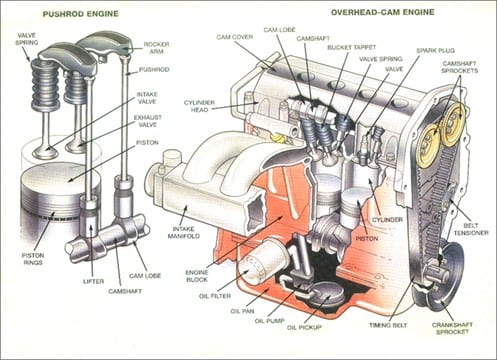
Cylinder liner Cylinder head gasket Piston Piston ring
Shandong Hexu Machinery Equipment Co.,Ltd , https://www.sdhxmachinery.com